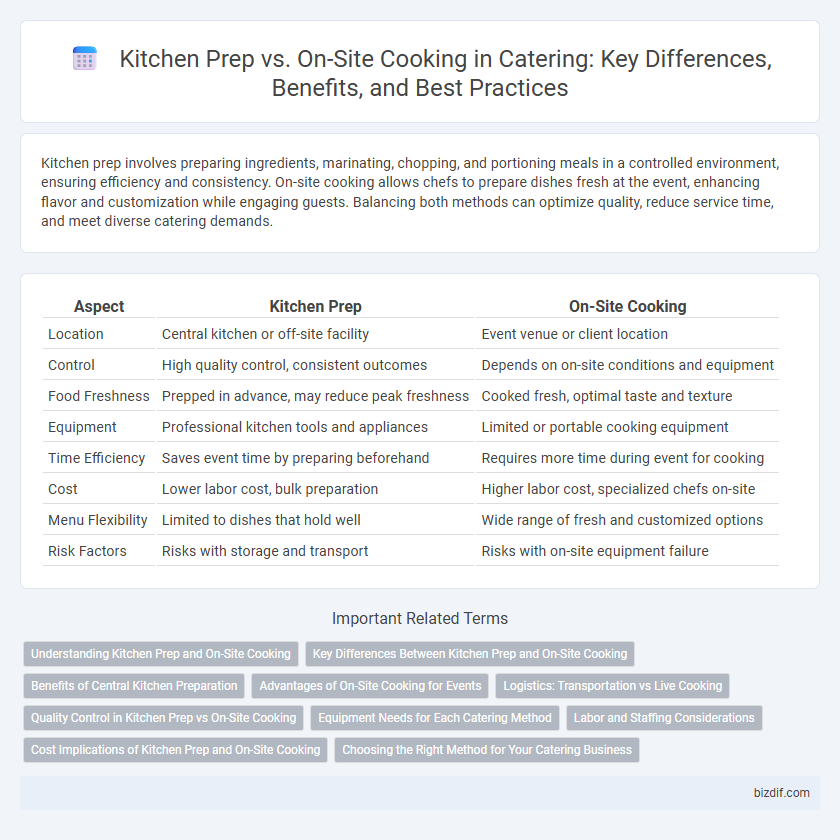Kitchen prep involves preparing ingredients, marinating, chopping, and portioning meals in a controlled environment, ensuring efficiency and consistency. On-site cooking allows chefs to prepare dishes fresh at the event, enhancing flavor and customization while engaging guests. Balancing both methods can optimize quality, reduce service time, and meet diverse catering demands.
Table of Comparison
| Aspect | Kitchen Prep | On-Site Cooking |
|---|---|---|
| Location | Central kitchen or off-site facility | Event venue or client location |
| Control | High quality control, consistent outcomes | Depends on on-site conditions and equipment |
| Food Freshness | Prepped in advance, may reduce peak freshness | Cooked fresh, optimal taste and texture |
| Equipment | Professional kitchen tools and appliances | Limited or portable cooking equipment |
| Time Efficiency | Saves event time by preparing beforehand | Requires more time during event for cooking |
| Cost | Lower labor cost, bulk preparation | Higher labor cost, specialized chefs on-site |
| Menu Flexibility | Limited to dishes that hold well | Wide range of fresh and customized options |
| Risk Factors | Risks with storage and transport | Risks with on-site equipment failure |
Understanding Kitchen Prep and On-Site Cooking
Kitchen prep involves the pre-production phase where ingredients are washed, chopped, marinated, and partially cooked in a centralized kitchen, ensuring efficiency and consistency for large-scale catering events. On-site cooking refers to the final stage of meal preparation conducted directly at the event location, allowing for freshly cooked dishes tailored to guest preferences and specific event conditions. Understanding the balance between kitchen prep and on-site cooking optimizes food quality, reduces service time, and enhances catering logistics.
Key Differences Between Kitchen Prep and On-Site Cooking
Kitchen prep involves preparing ingredients and dishes in a controlled environment before transporting them to the event location, ensuring consistency and efficiency. On-site cooking requires setting up full kitchen equipment at the venue to cook and finish dishes fresh, offering customization and immediate service. Key differences include logistical complexity, with kitchen prep emphasizing advance preparation and on-site cooking demanding skilled staff and real-time coordination.
Benefits of Central Kitchen Preparation
Central kitchen preparation enhances operational efficiency by streamlining food production and ensuring consistent quality across multiple service locations. This approach reduces on-site cooking time, minimizes the need for extensive kitchen space, and lowers labor costs by consolidating prep activities. Furthermore, centralized prep enables better inventory control and food safety compliance, improving overall catering reliability and customer satisfaction.
Advantages of On-Site Cooking for Events
On-site cooking for events ensures freshness and personalized menu customization, enhancing guest satisfaction through immediate preparation of dishes. It enables better temperature control and food safety by minimizing transportation and storage time. Interactive cooking experiences also create a lively atmosphere, engaging guests and elevating the overall event ambiance.
Logistics: Transportation vs Live Cooking
Kitchen prep involves preparing ingredients and partially cooking meals in a centralized location, allowing for efficient packaging and streamlined transportation to the event site. On-site cooking requires a well-equipped setup for live food preparation, demanding coordination of kitchen stations and real-time ingredient supply management. Transportation logistics prioritize temperature control and timely delivery, while live cooking depends on spatial arrangement and instantaneous resource availability.
Quality Control in Kitchen Prep vs On-Site Cooking
Kitchen prep ensures rigorous quality control by standardizing ingredient measurements, maintaining optimal hygiene, and enabling early detection of food inconsistencies before service. On-site cooking offers real-time adjustments to flavor and temperature but poses challenges for maintaining consistent quality under time pressure and variable conditions. Combining thorough kitchen prep with skilled on-site cooking maximizes overall food quality and customer satisfaction in catering services.
Equipment Needs for Each Catering Method
Kitchen prep for catering requires commercial-grade mixers, food processors, and large-capacity refrigerators to handle bulk ingredient preparation efficiently. On-site cooking demands portable stoves, warming trays, and mobile kitchen units designed for flexibility and temperature control during events. Choosing equipment tailored to each method ensures optimal food quality and service efficiency.
Labor and Staffing Considerations
Kitchen prep requires fewer on-site staff since most food is prepared in advance, allowing for a streamlined labor force focused on packaging and transportation. On-site cooking demands a larger, skilled team to handle real-time food preparation, ensuring freshness and customization but increasing labor costs. Staffing for kitchen prep optimizes efficiency through batch processing, while on-site cooking necessitates flexible scheduling to accommodate dynamic service needs.
Cost Implications of Kitchen Prep and On-Site Cooking
Kitchen prep typically reduces overall catering costs by allowing bulk ingredient purchasing and minimizing labor hours during event time, but requires upfront investment in storage and refrigeration. On-site cooking often incurs higher expenses due to specialized equipment rental, increased labor for chefs, and extended setup time, impacting the overall budget. Balancing these cost factors depends on event size, menu complexity, and client preferences.
Choosing the Right Method for Your Catering Business
Selecting between kitchen prep and on-site cooking hinges on factors such as menu complexity, event size, and available kitchen facilities. Kitchen prep offers consistency and efficiency by preparing dishes in advance, ideal for large events with limited on-site resources. On-site cooking enhances guest experience with fresh, customized meals, suitable for smaller, interactive gatherings where presentation and immediacy are priorities.
Kitchen Prep vs On-Site Cooking Infographic

 bizdif.com
bizdif.com